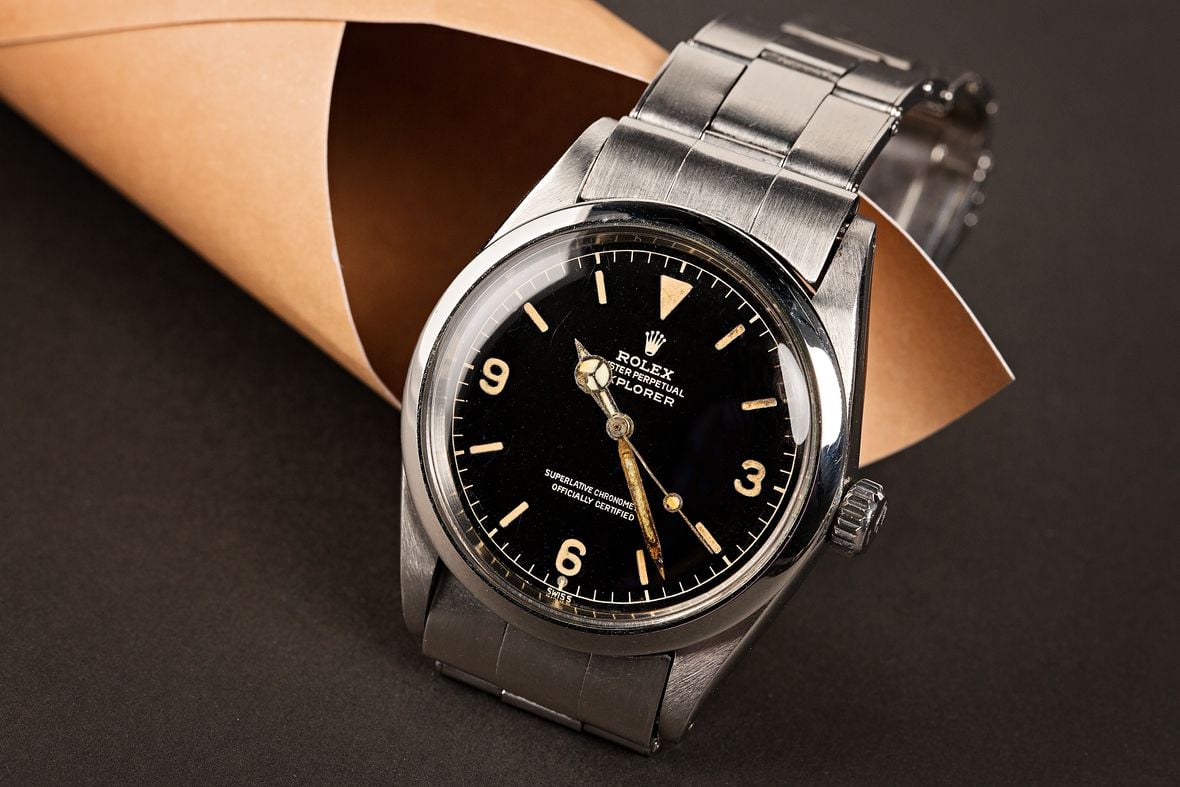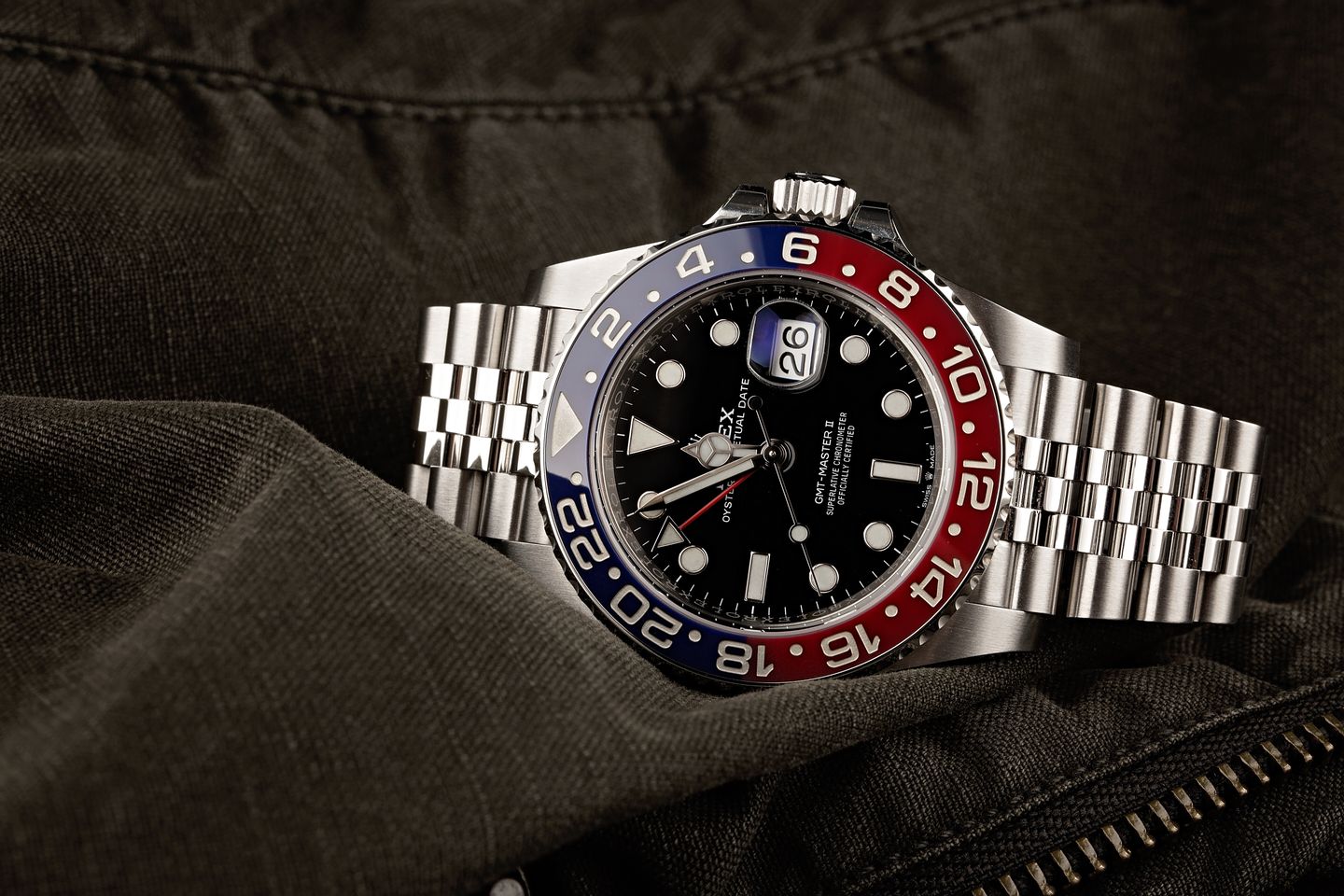The Rolex Explorer history is a testament to both watchmaking breakthroughs and human adventure. Originating from the first successful expedition to Mount Everest in 1953, this renowned watch has served as a loyal partner to explorers and adventurers for decades. The evolution of the Rolex Explorer mirrors the brand’s dedication to accuracy, toughness, and refined simplicity. Its lasting popularity among both professional explorers and watch collectors highlights its adaptability and classic look. As a key part of Rolex’s collection of sports watches, the Explorer still represents the essence of exploration and perseverance.
The Birth of the Rolex Explorer
The Rolex Explorer was introduced to the world in 1953, establishing a lasting connection between its brand and one of the most significant accomplishments in human history: the first successful climb of Mount Everest. This revolutionary watch emerged from Rolex’s deep ties with explorers and adventurers, who had been field-testing the brand’s timepieces in challenging environments for years.
Guided by Sir Edmund Hillary and Tenzing Norgay, the expedition to Everest was a crucial event in the world of horology and the history of mountaineering. While the exact model worn during the summit remains a subject of debate among experts in horology, Rolex took the chance to develop a watch that captured the essence of this extraordinary feat.
Made with explorers and adventurers in mind, the Rolex Explorer drew inspiration from the knowledge gained from numerous expeditions. Its sturdy build, easy-to-read face, and dependable movement made it the perfect partner for those striving to surpass human limits. The creation of the Explorer was a testament to Rolex’s dedication to crafting watches that could endure extreme conditions while still maintaining accuracy and style.
Technological and Design Innovations

Since its inception, the Rolex Explorer has consistently led the way in the realm of watch design and technology. In 1956, Rolex introduced the caliber 1030 movement to the Explorer, boosting its accuracy and dependability. This was succeeded by the adoption of the “Twinlock” crown mechanism in the 1960s, which greatly enhanced the watch’s water resistance.
The Explorer’s trailblazing features have left an indelible mark on the watchmaking sector. Its easily readable 3-6-9 dial design became a benchmark for numerous sports watches, emphasizing clarity in various conditions. The incorporation of luminescent elements on the dial, progressing from radium to tritium, and ultimately to Rolex’s own Chromalight technology, established new norms for visibility in low-light environments. These breakthroughs not only refined the Explorer but also shaped the evolution of other high-end watches in the market.
Additionally, the Explorer has embraced advancements in materials and construction that have enhanced its durability and performance. The introduction of the Paraflex shock absorber system significantly improved the watch’s resilience to impacts, making it an ideal companion for rugged adventures. The use of 904L stainless steel, known for its superior resistance to corrosion and wear, further cemented the Explorer’s reputation as a robust and reliable timepiece.
The Development of the Rolex Explorer
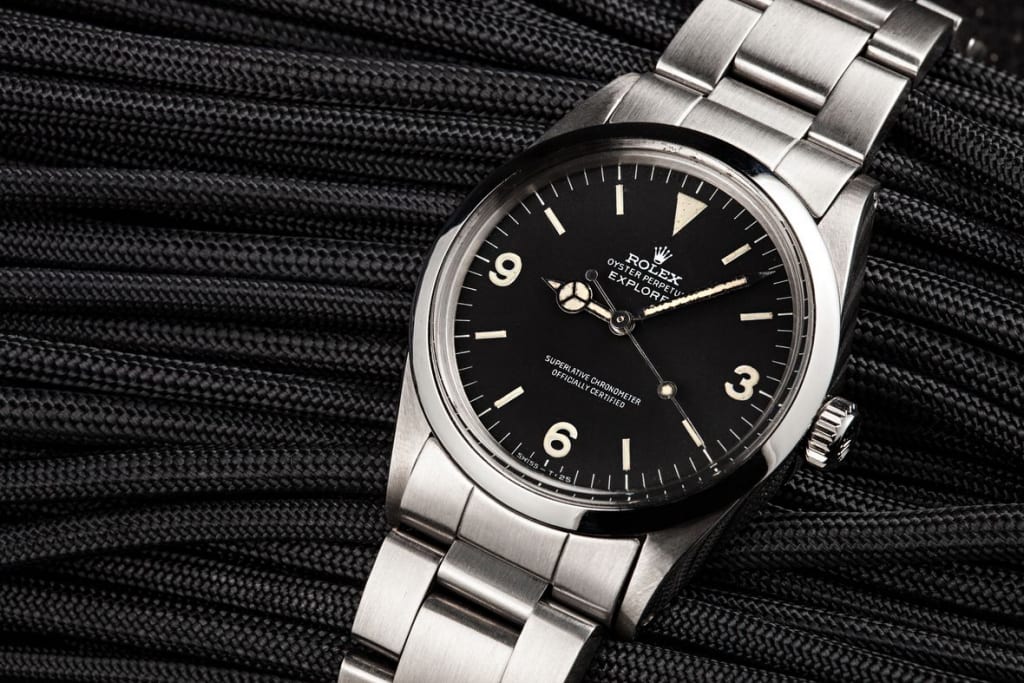
The development of the Rolex Explorer over the decades showcases a meticulous progression, striking a balance between honoring its initial design and incorporating contemporary advancements in watchmaking. Every new addition to the Explorer series has introduced minor yet important enhancements, enhanced functionality, and dependability while preserving the watch’s unique identity and purpose-driven design.
1953: The Debut of the Rolex Explorer (Ref. 6350)
The initial Rolex Explorer, model number 6350, laid the groundwork for all subsequent versions. Its defining characteristics included the now-famous 3-6-9 dial arrangement, which ensured clear visibility in a range of lighting situations. The sturdy 36mm Oyster case, made from stainless steel, provided strength capable of withstanding tough conditions.
The significance of the Everest journey to the Explorer’s design is immense. The severe weather of mountaineering at high altitudes required a watch that was not just precise but also easy to read and resistant to changes in temperature. The expedition’s triumph propelled the Explorer to renown, linking it to the essence of exploration and human accomplishment.
1960s: Refinement and Modernization (Ref. 1016)
The 1960s saw the introduction of the Rolex 1016, which would become one of the longest-running and most beloved Explorer models. This reference refined the Explorer’s design, featuring a more streamlined case and improved water resistance. The movement was upgraded to the caliber 1560, and later the 1570, enhancing accuracy and reliability.
The market reception of the reference 1016 was overwhelmingly positive. Its understated elegance and proven reliability made it popular not only among adventurers but also with a broader audience appreciating its versatile design. The 1016 played a significant role in establishing the Explorer as a cultural icon, worn by everyone from mountaineers to celebrities, cementing its status as a classic sports watch.
1989: Modern Enhancements (Ref. 14270)
Introduced in 1989, the Rolex 14270 brought the Explorer firmly into the modern era. This model saw the introduction of a sapphire crystal, greatly improving scratch resistance. The dial was updated with applied white gold hour markers, giving the watch a more luxurious appearance while maintaining its trademark legibility.
The movement was also upgraded to the caliber 3000, offering improved accuracy and shock resistance. These enhancements reflected Rolex’s commitment to continual improvement, ensuring that the Explorer remained at the forefront of watchmaking technology while respecting its heritage.
2010: Contemporary Upgrades (Ref. 214270)
The Rolex 214270, introduced in 2010, marked a significant update to the Explorer line. The case size was enlarged to 39mm, responding to the trend towards larger watches while still maintaining the Explorer’s wearability. The dial saw subtle modifications, with longer hands and slightly redesigned hour markers to complement the larger case.
This model also featured enhanced durability and performance, thanks to Rolex’s advancements in case construction and movement technology. The caliber 3132 movement, with Paraflex shock absorbers, provided improved resistance to shocks and extreme conditions. These upgrades ensured that the Explorer continued to live up to its name, ready for any adventure in the modern world.
Signature Features and Design Elements
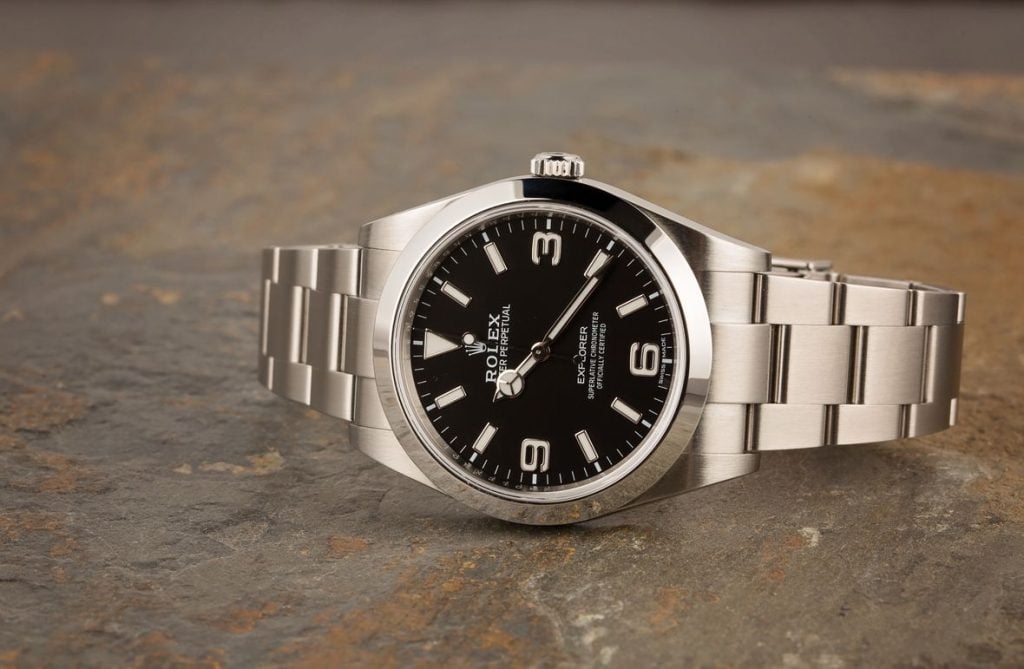
The Rolex Explorer has maintained a consistent design language throughout its history, with certain signature features becoming hallmarks of the model. These elements not only define the Explorer’s aesthetic but also contribute to its functionality as a tool watch designed for extreme conditions.
Legible Dial Design
The Explorer’s dial design, particularly its iconic 3-6-9 configuration, is perhaps its most recognizable feature. This layout, with large Arabic numerals at the cardinal points, was chosen for its exceptional legibility in all conditions. The simplicity of this design has become a classic in its own right, influencing many other sports watches.
Over the years, the dial has seen subtle evolutions. Early models featured painted numerals, while later versions introduced applied markers. The switch to white gold applied markers in the ref. 14270 added a touch of luxury without compromising readability. Luminous materials have also evolved, from radium to tritium, and finally to Rolex’s proprietary Chromalight, ensuring visibility in low-light conditions.
Durable Case Construction
The Explorer’s case has always been built to withstand extreme conditions. Crafted from Oystersteel, a corrosion-resistant alloy developed by Rolex, the case offers exceptional durability. The Oyster case design, with its screw-down crown and case back, provides robust protection against water and dust.
Water resistance has improved over the generations, from the early models’ 50-meter rating to the current 100-meter resistance. This enhancement reflects the Explorer’s evolution from a specialized mountaineering watch to a versatile sports timepiece. The introduction of the Twinlock and later Triplock crown systems further improved water resistance, making the Explorer suitable for a wide range of aquatic activities.
Precision Movements
The heart of any Rolex is its movement, and the Explorer has housed some of the brand’s most reliable calibers. Early models featured manually wound movements, but the line quickly transitioned to automatic calibers. The caliber 1030, introduced in the 1950s, set a new standard for reliability and precision.
Subsequent movements, such as the 1560 and 1570, brought increased accuracy and the addition of a hacking seconds feature for precise time-setting. Modern Explorer models house the caliber 3132, a self-winding mechanical movement entirely developed and manufactured by Rolex. This movement incorporates Rolex’s proprietary Paraflex shock absorbers, enhancing its resistance to shocks and extreme conditions. The consistent focus on improving the Explorer’s movements underscores Rolex’s commitment to precision and reliability.
Modern-Day Explorer
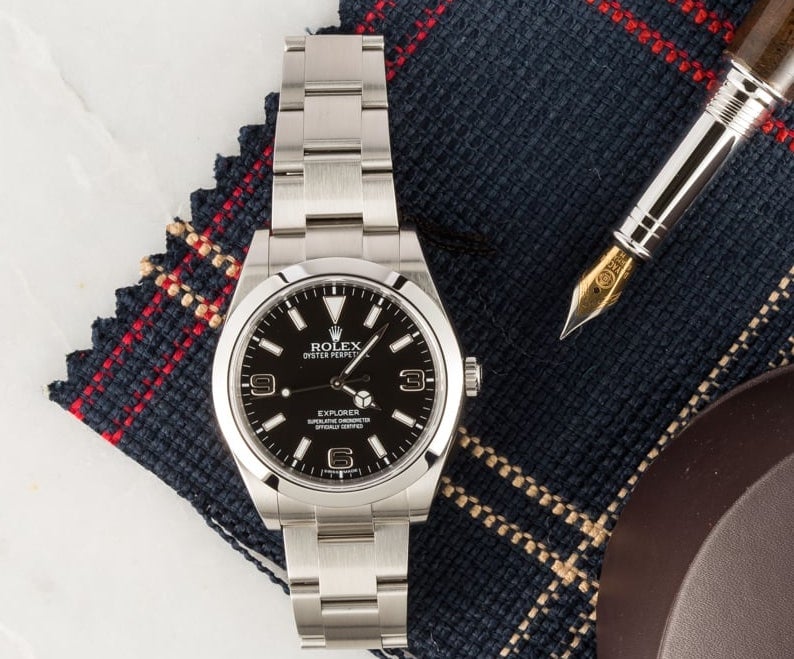
The Rolex Explorer continues to evolve, maintaining its adventurous spirit while embracing modern watchmaking technologies. Today’s Explorer model blends the watch’s rich heritage with contemporary features, appealing to a wide range of watch enthusiasts from seasoned adventurers to urban professionals.
As of 2023, the current Explorer lineup consists of the Rolex 124270. This classic Explorer returned to its iconic 36mm case size in 2021, a move widely celebrated by enthusiasts who appreciated the return to its historical dimensions. This model features the latest generation caliber 3230 movement, offering increased precision and a 70-hour power reserve.
Position in the Luxury Watch Market
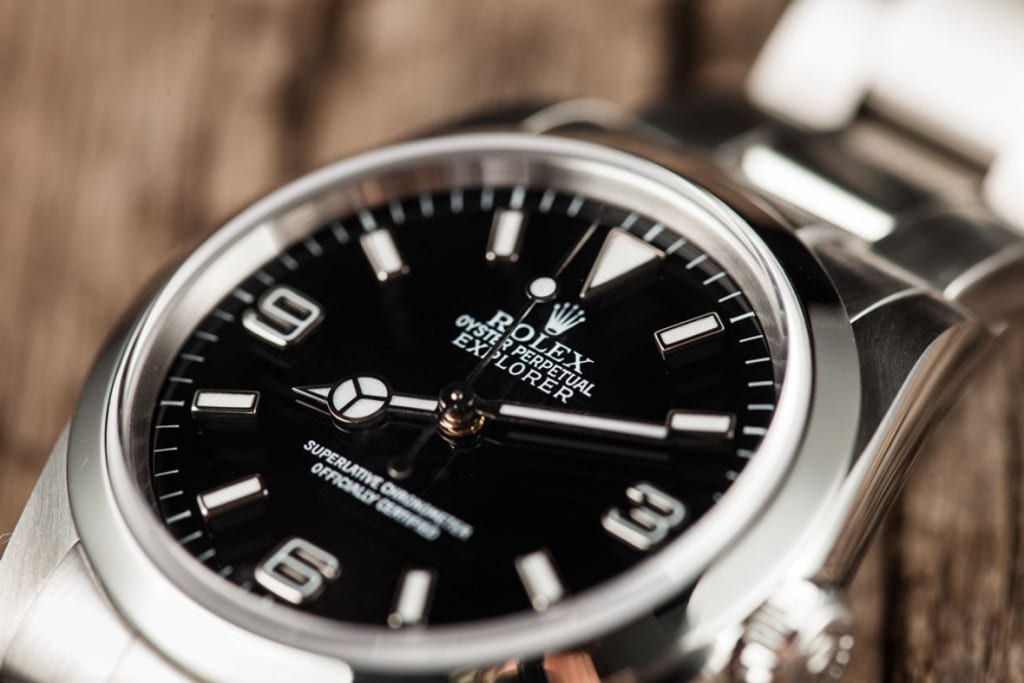
The Explorer occupies a unique position in the luxury watch market, particularly within Rolex’s sports watch lineup. While it may not have the mainstream recognition of models like the Submariner or Daytona, the Explorer has a dedicated following among watch enthusiasts who appreciate its understated elegance and robust capabilities.
Compared to other Rolex sports models, the Explorer offers a more subtle luxury. Its lack of a rotating bezel and its simpler dial design makes it versatile enough for both adventurous pursuits and formal occasions. This versatility, combined with its rich heritage, has contributed to its growing popularity in recent years.
In terms of investment potential, the Explorer has shown steady appreciation, particularly for vintage models. While it may not experience the dramatic price fluctuations of some other Rolex sports watches, it represents a solid choice for collectors looking for a combination of wearability and potential value retention. The recent return to the 36mm case size for the classic Explorer has also reignited interest in the model, potentially impacting its market position and value in the coming years.
Collectibility and Market Value
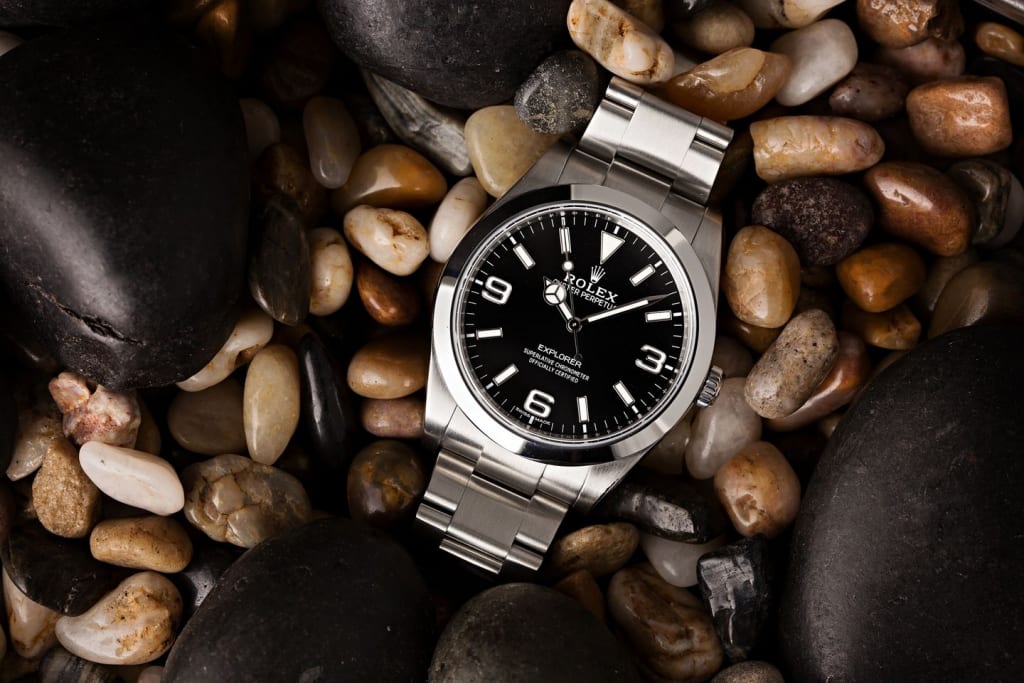
The Rolex Explorer has gained significant traction in the collector’s market over the years, with certain models becoming highly sought after. The watch’s unique place in Rolex’s lineup, combined with its rich history, has contributed to its appeal among collectors and enthusiasts.
Vintage Models
Vintage Explorer models, particularly early references, have seen a surge in collectibility and value. The reference 6350 and early examples of the 1016 are especially prized, with well-preserved specimens commanding premium prices. Collectors value these early models for their historical significance, unique design elements, and relative rarity.
Factors affecting the collectibility of vintage Explorer models include condition, originality, and provenance. Watches with original dials, hands, and bracelets are particularly valuable. Certain dial variations, such as the “honeycomb” texture found on some early models or the glossy gilt dials of early 1016 references, are highly sought after by collectors.
The Explorer’s association with mountaineering and exploration adds an extra layer of appeal for collectors. Models with a documented history of use in significant expeditions or owned by notable explorers can command extraordinary premiums. This historical connection sets the Explorer apart in the vintage Rolex market, appealing to those who value both horological and adventure history.
Current Market Trends
In recent years, the market for both vintage and modern Explorer models has shown strong performance. Vintage references, particularly well-preserved examples of the 6350 and early 1016 models, have seen significant appreciation. This trend reflects a broader interest in vintage Rolex sports watches and a growing appreciation for the Explorer’s understated design.
Modern Explorer models have also demonstrated solid market performance. The return to the 36mm case size in 2021 was well-received by the market, potentially impacting the value of both new and pre-owned models. While the Explorer may not experience the dramatic price fluctuations of some other Rolex sports models, it has shown steady appreciation and strong demand.
Looking ahead, the Explorer is likely to maintain its strong position in the market. The continued interest in Rolex sports watches, combined with the Explorer’s unique features and heritage, suggests a positive outlook for both vintage and modern examples. However, as with any luxury watch investment, potential buyers should consider factors such as condition, authenticity, and overall market trends when assessing the value of Explorer models.
Cultural Impact and Endorsements
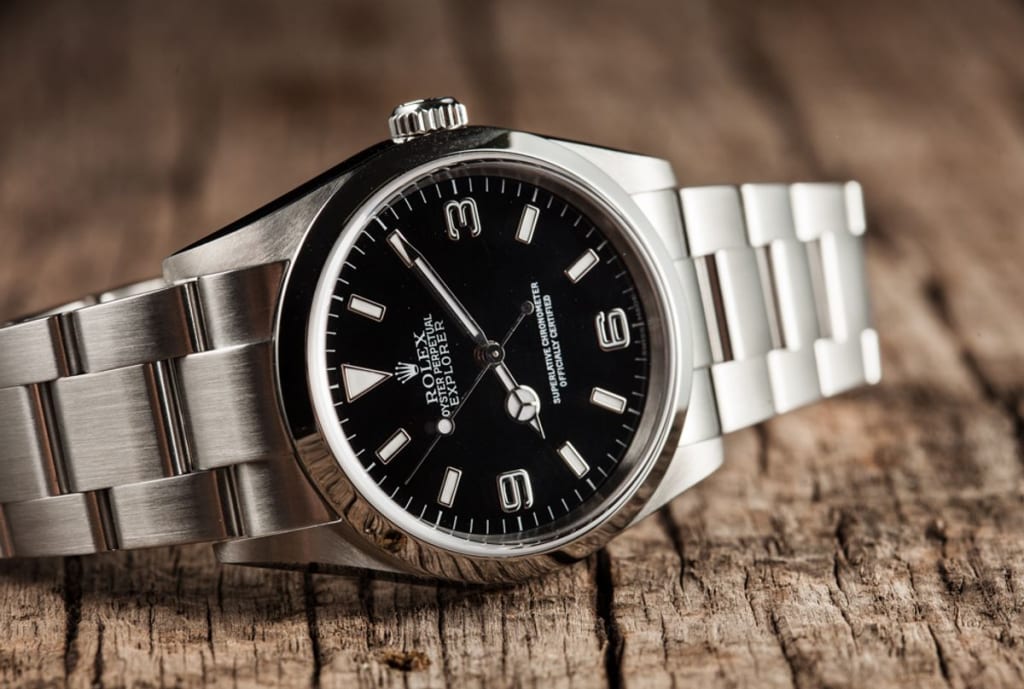
The Rolex Explorer, with its rich history and association with adventure, has made a significant impact on popular culture and garnered notable endorsements. Its understated design and robust functionality have made it a favorite not only among explorers and adventurers but also celebrities and watch enthusiasts.
Media Appearances
The Rolex Explorer has made numerous appearances in films, TV shows, and other media, often adorning the wrists of characters embodying adventure and sophistication. In the 1963 film “From Russia with Love,” James Bond, portrayed by Sean Connery, wears a Rolex Explorer, showcasing the watch’s versatility and appeal beyond pure adventure contexts.
The Explorer has also been featured in various documentaries and TV shows about exploration and outdoor adventures, cementing its reputation as a timepiece for the bold and adventurous. These media appearances have significantly impacted the Explorer’s popularity and public perception, elevating it from a specialized tool watch to a symbol of adventure and refined taste. The watch’s distinctive yet understated design makes it a favorite among costume designers looking to convey a character’s rugged sophistication.
Celebrity Endorsements
While Rolex typically doesn’t engage in traditional celebrity endorsements, the Explorer has found favor among many high-profile individuals, adding to its prestige and desirability. Notable wearers have included famous explorers, athletes, and entertainers, each bringing their own cachet to the watch.
For instance, Sir Edmund Hillary, one of the first climbers to summit Mount Everest, was known to wear a Rolex Explorer in his later years, reinforcing the watch’s connection to mountaineering history. In the entertainment world, Orlando Bloom has been spotted wearing Explorer models, showcasing the watch’s appeal beyond its original adventurer demographic and highlighting its versatility as a luxury sports watch.
The Explorer’s adoption by various celebrities and public figures has contributed to its enduring popularity and helped maintain its position as a desirable luxury timepiece. These unofficial endorsements often resonate more strongly with enthusiasts than traditional marketing campaigns, as they represent genuine appreciation for the watch’s qualities.
Conclusion
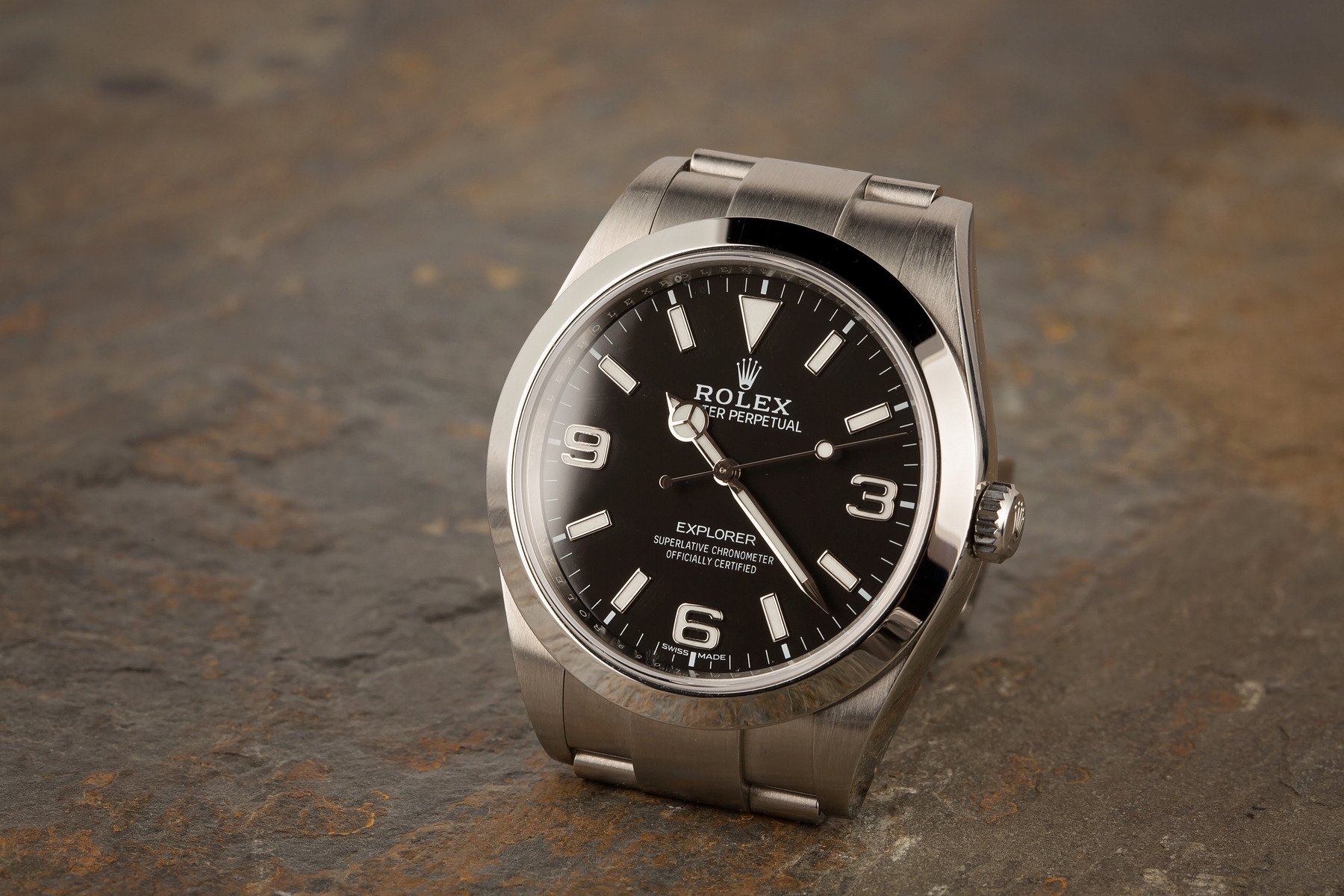
The Rolex Explorer stands as a testament to the enduring appeal of purpose-built luxury timepieces. From its origins at the peak of Mount Everest to its current status as a versatile luxury sports watch, the Explorer has consistently embodied Rolex’s commitment to precision, durability, and innovation. Its evolution over the past seven decades reflects not only advancements in watchmaking technology but also changing tastes and needs of watch enthusiasts.
Throughout its history, the Explorer has maintained its core identity while adapting to the times. The iconic 3-6-9 dial configuration and robust construction remain hallmarks of the design, connecting modern iterations to their adventurous roots. This blend of heritage and innovation has secured the Explorer’s place as a favorite among collectors and enthusiasts, appealing to those who appreciate both its functionality and its storied past.
For those looking to own a piece of this horological legacy, Bob’s Watches offers an excellent selection of Rolex Explorer for sale. Whether you’re drawn to the vintage charm of early references or the refined technology of modern iterations, our carefully curated collection includes options to suit various preferences and budgets. As authorized dealers with a reputation for authenticity and quality, we invite you to explore our range of Rolex Explorer watches and find the perfect timepiece to accompany you on your own adventures, be they scaling mountains or navigating daily life.
